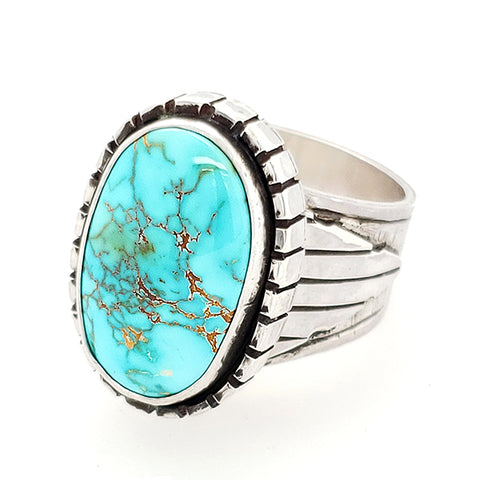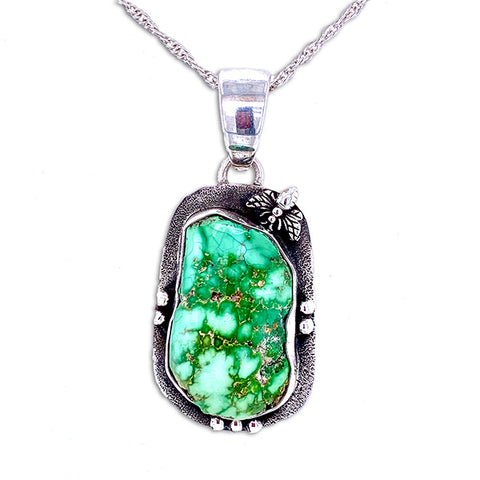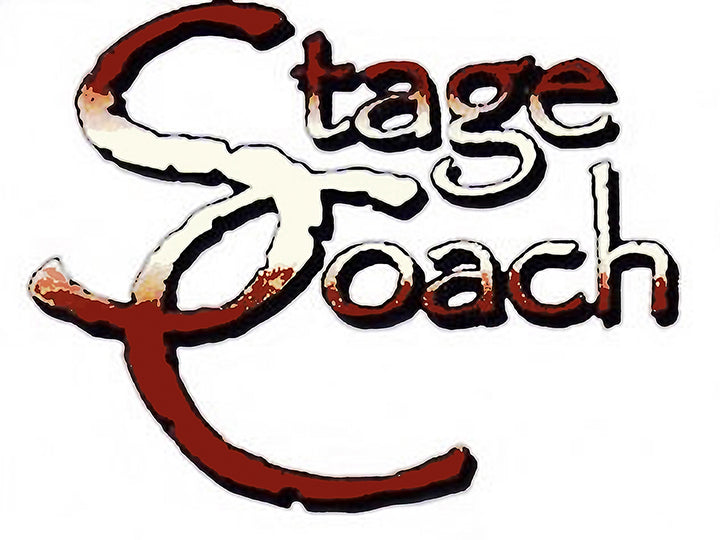Currently All David Rosales Jewelry Requires 6 Weeks To Make
Currently All David Rosales Jewelry Requires 6 Weeks To Make
July 10, 2020 6 Comments
What is meant by the term “natural” turquoise? Isn't all genuine turquoise natural? Well, no, not according to the proper terminology when discussing treatments applied to these stones. Turquoise jewelry has been desired for centuries due to its beautiful colors. You can read about our article about the History of Turquoise Jewelry here. The stone has a history of being altered for almost that same long timespan. Even the early Egyptians were known to use fakes when genuine was not available. Hopefully, this guide will help you to understand the different treatments to “enhance” the stone.
What is Natural Turquoise?
Natural turquoise is exactly what the name implies, completely natural with no chemicals, waxes, or any other treatments. Less than 5% of genuine turquoise is hard enough to be used in jewelry without treatment and be considered completely natural. Most of this material is very porous when it comes out of the ground and doesn’t take a good shine. When it is being cut it can be very brittle and crack or fall apart. Once the stone has been cut and set in jewelry, you must ensure that it is hard enough to withstand a normal amount of wear. Also, if a stone is too porous it will absorb oils from your skin which will cause the stone to fade or change color over time. Some of the treatments that we are going to discuss are meant to harden the stones for use in jewelry.

This natural Royston Turquoise ring was handmade by Gary Glandon. Royston is one of our favorite types and Gary gets all of these stones straight from the miner.
Only the highest quality material, the harder gem-grade stone that can be used with no treatments is deemed natural. This high-grade natural stone is typically what collectors are looking for. For enthusiasts, this designation is very important. Because only 5% of genuine turquoise is natural the price of this is much higher than treated stones. Combine that with the dwindling supply and you can see why it demands a premium price.
Typically, it is next to impossible to determine after the fact if a specific stone is natural or if it has some sort of treatment. A person with experience can normally tell if a stone is genuine or if it has been dyed or reconstituted (more on that below). Some of the other treatments are more difficult to decern. There are also of stones that we could venture an educated guess that they have been stabilized. However, not even the very top experts could definitively say that a stone is completely natural just by looking. This is why it is important to get this information straight from the jeweler when purchasing a piece of turquoise jewelry if this knowledge is something that is important to you.
Enhanced Turquoise
Enhancement is the closest treatment to purely natural and it is the least intrusive. A stone is electrochemically treated to improve its color and luster. No resins or dyes will be found here and it is almost impossible to tell the difference between natural and enhanced stones. Enhancement is a good term for this technique because it does not change the makeup of the stone. It simply brings out more color and improves the overall appearance.
This type of treatment was invented by James Zachery and is known as the Zachery Enhancement method. A second enhancement method was developed by Elven Jennings and is known as the Eljen treatment. At Stagecoach we used to get a lot of our Number 8 Turquoise from Elven Jennings that had undergone his process. While both of these techniques are very similar to each other, they are each proprietary to the developers. These techniques are closely guarded and the specifics are not commonly known outside of their respected businesses.

An Indian Mountain Turquoise pendant that was handmade by Gary Glandon. Gary got this enhanced stone from the Zachary Method group. It has a bright and vivid color that is very eye-catching.
Both of these methods improve the color of the turquoise and help with fading. To be clear, there is absolutely nothing wrong with enhancement and both of the developers are respected throughout the industry. The benefits of enhancement are that the price may be somewhat lower than natural and the stones may last longer without fading. The stones may not be quite the same level of quality (though close and still potentially very beautiful) and you cannot give them the coveted natural label.
What is Stabilized Turquoise?
Stabilized turquoise is a process of hardening turquoise stones so they can be used in jewelry.
Many people are aware of stabilization because this treatment has been around since the 1950s. The Colbaugh family, who also own the large Kingman mine, first developed this process. Through the use of high pressure, epoxy is forced into the porous stone to harden it into jewelry-grade. This helps make it stronger and able to take a better cut and shine. Many chalk-like turquoise stones that would otherwise be worthless because of their softness, can be stabilized and used in jewelry.
There are several different methods of stabilization and not all are equal. Some use oil or wax to stabilize a stone but this does not produce a quality result and is generally frowned upon. Good quality stabilization is difficult to do and can take months to complete. While the process does sound less than appealing, most of the genuine turquoise that you see on the commercial market has been stabilized. As long as the process has been done by a reputable operation, there is nothing wrong with stabilization. These can be used in quality jewelry and are usually much more affordable and readily available.

This stabilized Kingman Turquoise is one of my favorite stones that Gary currently has in his collection. It has such a rich variation of colors ranging between blue, green, and yellow. As you can see with this example, there is nothing wrong with stabilized stones and they can be beautiful and high-quality.
As opposed to enhancement, experienced collectors can sometimes tell if a stone has been stabilized. The easiest way to state this is that some stones are fairly easily recognized as stabilized but with others, it may be difficult to rule out. Most noncollectors would struggle to notice any difference with stabilized stones.
Waxing and Oiling
The oldest method of treating turquoise is by using oil, animal fat, or wax to bring out the color and also protect it from the elements. These methods are still used today and do no harm to the stone. The main problem with this method is, unlike stabilization, the oils or wax eventually wear off and have to be reapplied.
Dyed Turquoise
As the name implies, dying is the process of completely changing the look of a stone. This not an acceptable way of treatment because it completely changes the makeup of the stone. Unfortunately, dealers or jewelry stores are often not upfront about dyeing. Worse yet, is the practice of dyeing other inexpensive stones such as howlite or marble to fake the look of turquoise.
An example of one of the problems with dyeing can be seen with Mohave Turquoise. Mohave is often believed to be naturally purple. In fact, there is no natural purple turquoise; Mohave is 100% dyed. Sadly, this is not explained to customers most of the time. We have had customers get very defensive because they believe or were told that it is real. At the same time, a lot of people love purple Mohave, whether its color is natural or not. We have even carried a small amount at Stagecoach in the past but are always upfront about what a customer is purchasing. There is nothing wrong with this type of stone as long as people are not being misled about their purchase.
Reconstituted Turquoise
Another common method of treatment is reconstitution. Low-quality turquoise is ground into a powder and mixed with epoxy and blue dye and formed into cabochons or beads. Again, this is not an acceptable method of treatment. In this case, “treatment” may not even be an appropriate term because reconstituted is technically not turquoise, to begin with. This technique is more along the lines of manufacturing something that has the same color but is mostly epoxy. Consider the actual definition of reconstitution. According to the Oxford dictionary, reconstitute means to reconstruct or change the form of something from parts. This term may be tolerable in food but you do not want it in an expensive piece of jewelry. This should only be used in inexpensive costume jewelry and should not be labeled turquoise.
This should give you a good idea of the different techniques that are used for treating turquoise. As you can see, some of these are more acceptable than others. When shopping at Stagecoach you can trust that every piece of turquoise jewelry uses stones with an acceptable treatment method. Most of Gary's handmade jewelry uses completely natural turquoise that he gets straight from the individual miners. You can shop Gary's ever-changing Nebraska Handmade Jewelry here. Rest assured that we will never sell dyed stones in our jewelry unless it is clearly labeled. The only dyed turquoise that we have ever sold was a few strands of Mohave beads and we made sure to inform the customers of what of this. I believe that being upfront about this labeling is very important for the entire industry. When purchasing a car it is frowned upon when a salesperson is not clear about the condition of the vehicle. The same standards should be held for reconstitution and dyeing in jewelry. This is something that we firmly believe in and we always do our very best to provide you with this information. At Stagecoach we go to great lengths and expense to provide you with a high-quality collection that is not found in many other stores. Stay tuned for a related article on a few shady practices that we see in the otherwise wholesome and untarnished jewelry trade.
December 04, 2022
you guys have some of the most dynomite turquoise I’VE EVER SEEN…..I’LL BE ORDERING SOMETHING SOON , THANKS
TOOTY
October 14, 2022
Hi, can you tell me if authentic turquoise would chip or a part of it flake off, leaving an ugly grey/brown color underneath? I bought a navajo piece advertised vintage but arrived shiny new silver and on first wearing blue has chipped off edge of a corner of one stone. Is it a fake stone?
February 06, 2022
I love your articles on Turquoise! My first piece I ever got was a baby ring with a Thunderbird on it. My second was when I was around 6yrs old. I received a matching Turquoise bracelet and ring when my grandmother passed that I just love. And she had that back as far I could remember. No marks on it as to the artist who created it and I’ve had numerous offers to buy it.
I came across a comment about a piece Turquoise and was hoping you might know what they meant by it. It was a "Freshened Turquoise " bracelet. So, it gave me pause to even purchase it. I was hoping you would know what they are talking about. It’s not the first time they have used the term.
Thank you so much your time is greatly appreciated. I love your jewelry pieces!
July 17, 2021
I have recently found a deposit of turquoise and dug a little of it up and I am trying to polish some of it up but its proving difficult.I have some that is greener and some that is sky blue with royal blue specs.It really does look like Robin’s egg.The green kind is easy to polish it’s kind of waxy.The blue kind is porous and chalky but after hand polishing it some it is very pretty.I was wanting to know a good method for polishing without treating.Thank you.
September 27, 2020
Enjoyed your article. I have always been a rockhound. Some of my first pieces were simple, but turquoise that my father bought me as a child. Your stone pic above absolutely beautiful. My husband has bought several jewelry sets from your store. You have a great selection.
August 31, 2025
April 16, 2025 1 Comment
Discover the rich history, striking beauty, and ancient origins of Egyptian turquoise, mined in the Sinai and treasured since the days of the Pharaohs.
January 24, 2024 1 Comment

jmay
April 28, 2023
I have raw untreated baby blue turquoise. from hachita nm.